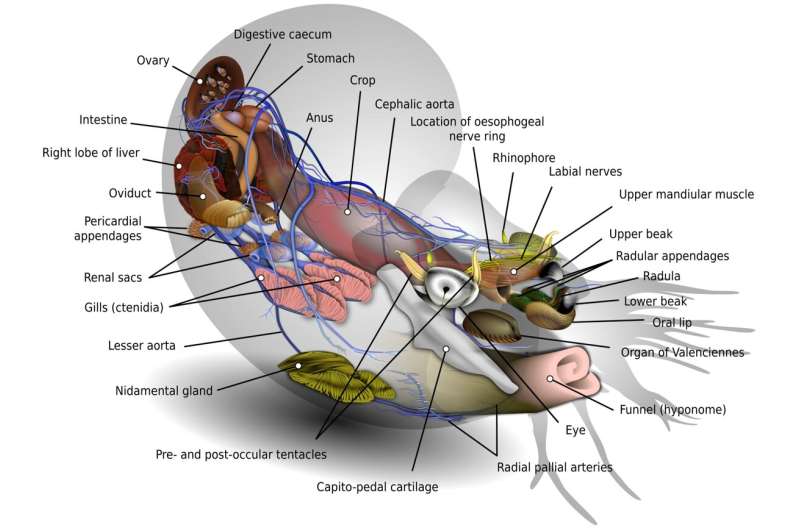This article has been reviewed according to Science X's editorial process and policies. Editors have highlighted the following attributes while ensuring the content's credibility:
fact-checked
proofread
More nautilids may have survived the mass extinction at the end of the Triassic period than previously thought

The end of the Triassic period, 201 million years ago, is considered one of the greatest mass extinction events in the history of the Earth. The main cause of this catastrophe for life and evolution is thought to have been intense volcanism in Siberia. This led to worldwide climatic turbulence and acidification of the sea water.
Among sea creatures, ammonites and nautilids were particularly affected. Until now, it was assumed that only a single genus of each of the two groups survived this period of crisis and that all subsequent diversity of species evolved from these two surviving lineages. This idea has now been revised due to the examination and re-evaluation of an extraordinary 185-million-year-old nautilid from the middle Early Jurassic of Behla near Donaueschingen, Germany.
The fossil has been in the collection of the Stuttgart Natural History Museum since 1975. Dr. Günter Schweigert, paleontologist at the museum, has now researched the fossil nautilus and described it in the journal Neues Jahrbuch für Geologie und Paläontologie as a new species, Germanonautilus warthi.
Valuable new insights for the evolution of the nautilids
Nautilids are generally much rarer than those of ammonites and many fossil species are only known from chance finds. This makes the discovery of Germanonautilus warthi all the more valuable for experts. The fossil revises the evolutionary scenario at the Triassic-Jurassic boundary from the 1950s, which dates back to the American paleontologist and nautilid researcher Bernhard Kummel (1919-1980).
"The specimen clearly belongs to Germanonautilus, a genus that was widespread worldwide in the Triassic period. For a period of 15 million years, there is no evidence of Germanonautilus, but the genus, together with other nautilids, must have survived the crisis at the Triassic-Jurassic boundary somewhere," says Dr. Günter Schweigert. The new species therefore provides valuable new clues to the evolution of nautilids.
Significance of the find remained hidden for a long time
The curator in charge made the find in the 1970s during field work and classified the specimen in the collection. Since the fossil had not yet been prepared at the time, Germanonautilus warthi was thought to be a representative of Cenoceras, the genus to which almost all nautilids from the Lower Jurassic period belonged. Since Jurassic nautilids had not been scientifically revised for decades, the significance of the find remained hidden until now.
"Some shell features of Germanonautilus also suggest that a quite successful family of younger Jurassic nautilids has its direct roots to this genus, but the traditional assumption that all post-Triassic nautilids go back to Cenoceras clouded this view," says Dr. Günter Schweigert. The paleontologist is sure that the new findings can provide valuable clues for future studies on the evolution of prehistoric and present-day marine fauna.
Unlike the ammonites, the nautilids have survived until today, but are currently severely threatened by overfishing and habitat destruction.
More information: Günter Schweigert, First record of Germanonautilus Spath, 1927 (Cephalopoda: Nautiloidea) from the Lower Jurassic (Pliensbachian) of SW Germany and its implications for the phylogeny of post-Triassic nautilids, Neues Jahrbuch für Geologie und Paläontologie—Abhandlungen (2023). DOI: 10.1127/njgpa/2023/1131
Provided by Staatliches Museum für Naturkunde Stuttgart





















